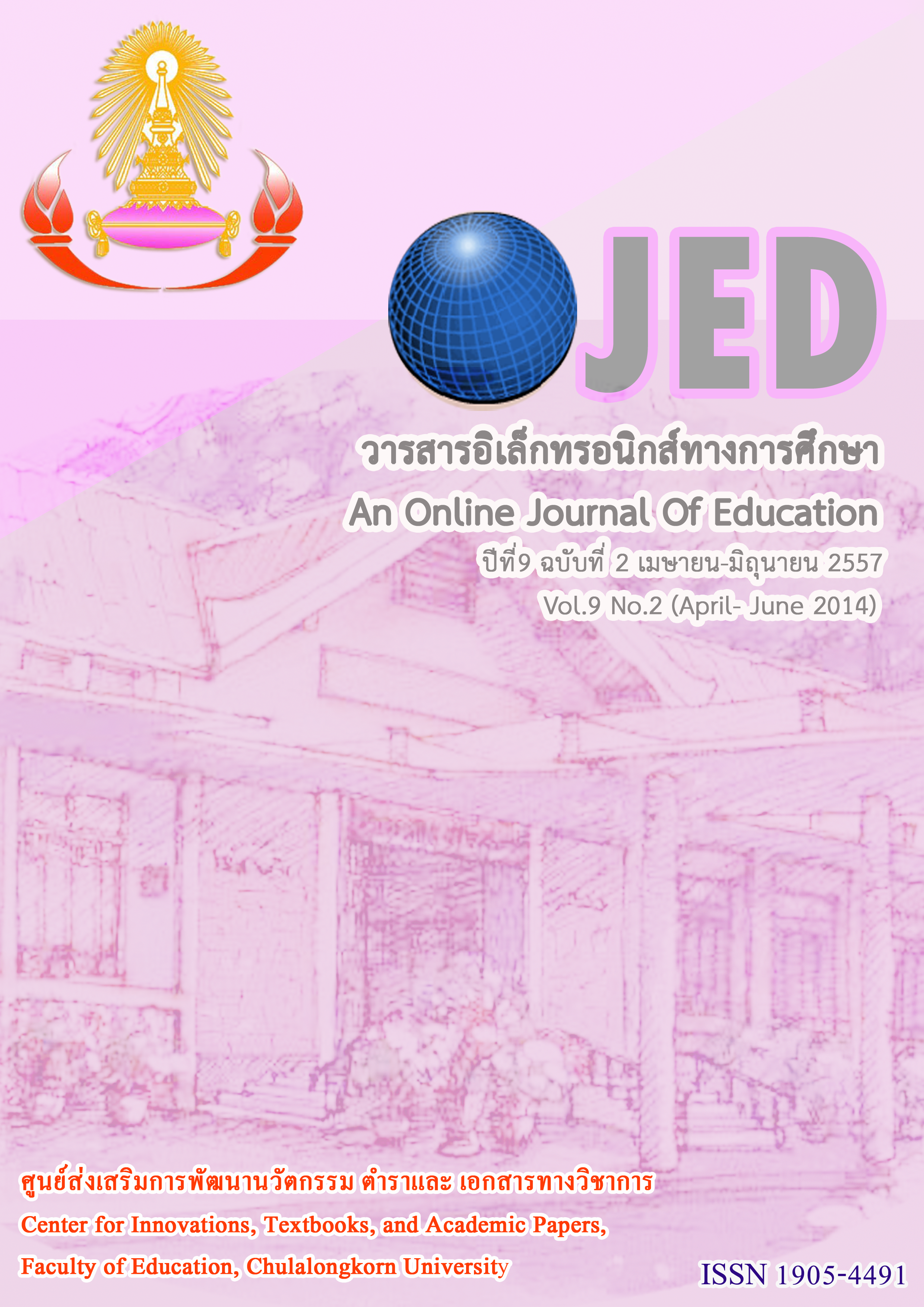การศึกษาวิธีการถ่ายทอดดนตรีไทยในโรงเรียนและบ้านดนตรีไทย
Keywords:
การถ่ายทอด, การสอน, การประเมิน, การปฏิบัติ, TRANSMISSION, INSTRUCTING, EVALUATED, PRACTICAL ACTIVITYAbstract
บทคัดย่อ
การวิจัยครั้งนี้มีวัตถุประสงค์ 1) เพื่อศึกษาวิธีการถ่ายทอดดนตรีไทยในโรงเรียนสาธิต "พิบูลบาเพ็ญ" มหาวิทยาลัยบูรพา 2) เพื่อศึกษาวิธีการถ่ายทอดดนตรีไทยในบ้านดนตรีไทยผู้ใหญ่ถาวร แสงจิต โดยใช้ระเบียบวิธีการวิจัยเชิงคุณภาพ และเชิงปริมาณ จากการสัมภาษณ์ การสังเกต และแบบสอบถาม กลุ่มตัวอย่างได้แก่ ผู้ถ่ายทอดในโรงเรียน คืออาจารย์ประดิษฐ์ อินทนิล และผู้รับการถ่ายทอด จำนวน 65 คน ผู้ถ่ายทอดในบ้านดนตรีไทยคือ ผู้ใหญ่ถาวร แสงจิต และผู้รับการถ่ายทอด จำนวน 15 คน เครื่องมือในการวิจัยมี 3 ชนิด ได้แก่ 1) แบบสัมภาษณ์ 2) แบบสังเกต 3) แบบสอบถาม เก็บรวบรวมข้อมูลโดยการศึกษาเอกสาร สัมภาษณ์แบบไม่เป็นทางการ และวิเคราะห์ข้อมูลโดยการนาเสนอในรูปแบบตาราง และความเรียง
ผลการวิจัยมีดังนี้ 1. วิธีการถ่ายทอดดนตรีไทยในโรงเรียน มีขั้นตอนการถ่ายทอดดังนี้ 1) ทำความเข้าใจในเนื้อหาสาระ 2) การอธิบายพื้นฐานด้านดนตรีไทยเบื้องต้น 3) เลือกเครื่องดนตรีที่สนใจปฏิบัติ บรรยาย/สาธิต 4) ผู้เรียนลงมือปฏิบัติ 5) ผู้สอนติดตาม และประเมินอย่างใกล้ชิด 6) ประเมินผล วิธีการในการถ่ายทอดอยู่ในระดับ มาก (M = 2.6, S.D. = 0.49) 2. วิธีการถ่ายทอดดนตรีไทยในบ้านดนตรีไทย มีขั้นตอนการถ่ายทอด โดยแบ่งผู้เรียน ออกเป็น 2 กลุ่ม ประกอบไปด้วย กลุ่มผู้เรียนพื้นฐาน มีขั้นตอนดังนี้ 1) สอบถามความพร้อมก่อนการศึกษา 2) เรียนรู้การบรรเลงให้ตรงคู่เสียงโดยการจับมือตี 3) ปฏิบัติเพลงสาธุการ ชุดโหมโรงเย็น 4) การวัดผลและการประเมินผล กลุ่มผู้เรียนที่มีความสามารถอยู่แล้ว มีขั้นตอนดังนี้ 1) มีการทดสอบก่อนเรียน 2) เรียนเพลงประเภทเพลงเรื่อง และเพลงเถา 3) การวัดผลและการประเมินผล วิธีการในการถ่ายทอดอยู่ในระดับ มาก (M = 2.6, S.D. = 0.63)
คำสำคัญ: การถ่ายทอด / การสอน / การประเมิน / การปฏิบัติ
Abstract
The study aims to investigate the transfer of knowledge about Thai classical music at Piboonbumpen Demonstration School (PDS), Burapa University and at Baan Puyai Thaworn Sangjit (BPTS) (House of the Village Head, Thaworn Sangjit) and applied both quantitative and qualitative methods. The participants of the first group were Pradit Intanin, teacher and mentor, and his 65 students. The participants of the second group were village head, Thaworn Sangjit and his 15 students. The research methodology included interviews, observation, and questionnaires. The data were collected from printed documents and informal interviews. The results are presented in texts and tables.
The results of the study are as follows. At PDS, Burapa University, the instructor taught by (1) making clear lesson plans; (2) giving background information about Thai classical music; (3) allowing students to choose the musical instrument they were interested in; (4) giving lectures and demonstrations; (5) encouraging students to practice and (6) facilitating and evaluating the students' performance. It was found that the transfer of knowledge at PDS was effective at M=2.6, and S.D.=0.49. At BPTS, the transfer of knowledge was achieved primarily through practice. Students were divided into two groups, beginners and intermediate learners. For beginners, the mentor taught by (1) asking if the students were ready to learn; (2) having students practice the intervals while the mentor held the students' hands to practice; and (3) practicing Pleng Satukarn (salutation song), and Hom Rong Yen (overture); and finally (4) the mentor evaluated the students' performance. For intermediate learners, the steps were: (1) a pre-test; (2) learning about a series of Thai classical songs; and (3) the mentor’s evaluation of the students' performances. It was found that the transfer of knowledge at Baan Puyai Thaworn Sangjit was effective at M=2.6, and S.D.=0.63.
KEYWORDS: TRANSMISSION / INSTRUCTING / EVALUATED / PRACTICAL ACTIVITY




